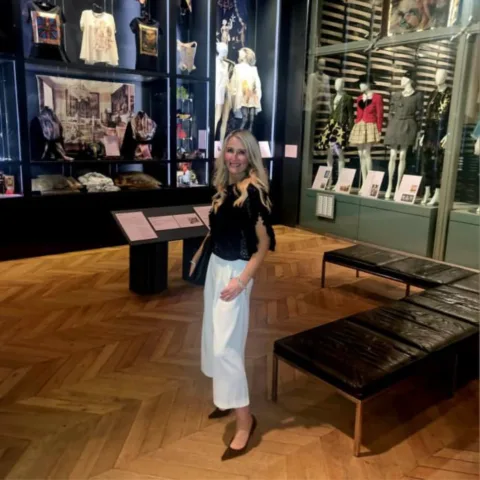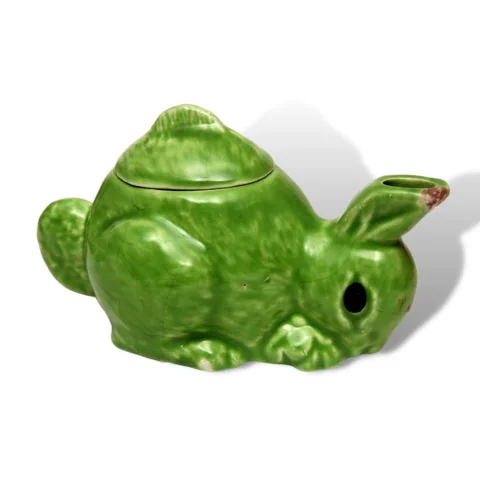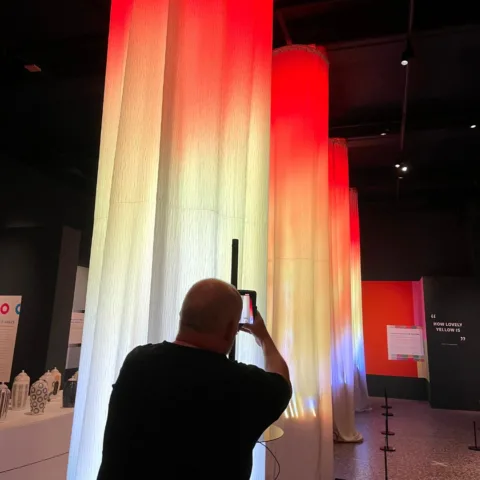The Bowes Museum Blog

Illuminations
On a beautiful Spring day driving over Bollihope moors towards Barnard Castle, I had absolutely no inkling of how my creative life was about to change.
Lapwings were tumbling merrily, curlews sharing their echoing, haunting cries, the occasional sheep doing its best to give me a heart-attack by strolling nonchalantly across the road in front of me….
A phone call to The Bowes Museum a few days earlier inquiring about illuminated Books of Hours – were there any at Bowes?- resulted in an invitation to meet the Keeper of Ceramics, Howard Coutts.
“Why the Keeper of Ceramics?” I asked.
“ Oh, he looks after the Library as well,” was the breezy answer.
And so began a new and very important connection in my life.
Howard met me in the entrance hall, which had barely changed for many years, and bustled me off to a large room on the ground floor. Heavy old fashioned bookcases were filled with what at first appeared to be heavy old fashioned tomes – which many were. Howard went off to find a stepladder, then found several very small books balanced on a top shelf, which were casually dropped (from no great distance, I add quickly) into my waiting hands.
Howard kindly suggested I make myself comfortable, take my time, and be prepared to find that some of the books had been quite damaged by the time John and Josephine acquired them.
But nothing prepared me for what happened next!

Opening the first small book at random, I literally felt a sense of vertigo – a new miniature world had appeared in front of me; a vibrant world of colour, pattern, and detail, enhanced even more by the rich, glorious accents of gold leaf – I had discovered total beauty, and it had spoken to me.

Book of Hours, Use of Rome, in Latin, Illuminated Manuscript with 9 miniatures on parchment, 148 x 100 cm, made probably in Bruges, 15th century
Some of the books had been damaged by water, fire, and mishandling, as Howard said, but nothing could hide the original beauty created by the mainly French, Flemish, Netherlands scribes and illustrators who were commissioned to create them.
Age-wise some dated from around the late 15th century, and to my untutored eye had done pretty well to have survived to the day of my visit, considering the indignities they’d undergone.

The detail of the decorative page margins of interwoven flora and sometimes fauna, the use of colour, often symbolic, all of these qualities and more, resonated within me. I knew instinctively that The Bowes Museum had given me a stability and feeling of security which no other establishment at that point in my life had.

Two hours later, in the cafe with Howard (who stood me a cappuccino voluntarily!) I was in a state of euphoric bliss.
And when he said, quite casually, that I was welcome to pop over from Lanchester any time to see the books- my cup overflowed. (Metaphorically speaking, not the coffee cup…).
That special day will live with me forever. Yes, since then I occasionally visit the V&A Museum and the British Library in London, and Durham Cathedral’s Library, to research manuscripts there – and marvel at the wealth of priceless, beautiful manuscript material but nothing has compared to the breathless sense of wonder I felt on that special day many years ago at the Bowes.

My first exhibition of paintings was held there shortly afterwards, which opened the door to my present career. September this year sees the opening of my second expo at The Bowes Museum.

Judith Hurts in the studio
I believe and hope that the inspiration I found on that special day, tucked away in a rather dusty room, will be seen as a celebration and homage to an art form that for many years was relegated to history. It is only relatively recently that public awareness has grown (and still is growing) about both the beauty of the illustrated story in illuminated Books of Hours, and the fact that vellum (calfskin) will endure for hundreds of years.
Vellum genuinely is the only material which will hold the written word and illustrations for centuries.
I hear people (not you, of course- you know better!) cry, “ The digital tools, the memory sticks, the modern technological methods of recording-“… and I respond, “What about the fact that we need electricity to make such archived material live?”
Recording on paper has limited life too, as we know. We can reprint as often as we need in our modern world thank goodness, but I do think that vellum is in a sense, even more modern.
After all, it is the only material that has the provenance, doesn’t it?
Respect!
By artist Judith Hurst
Judith Hurst’s exhibition will open in September 2019. For more details keep an eye on our website and social media platforms:
LinkedIn – The Bowes Museum







